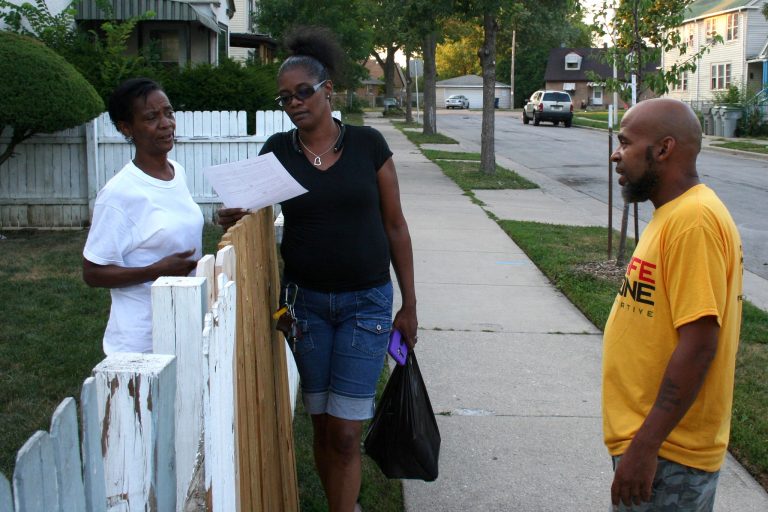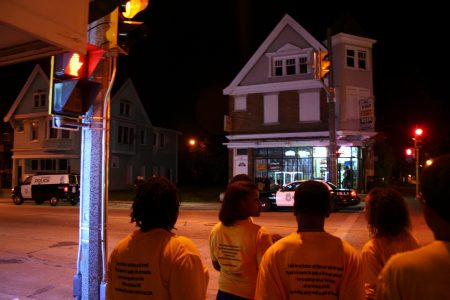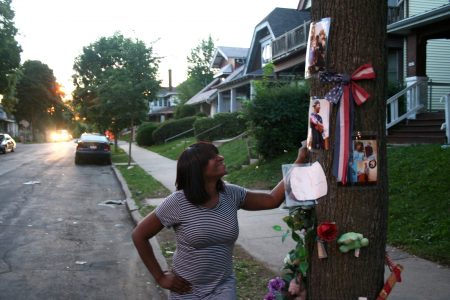Safe Zones Project Sees Success
Community policing helped homicides, shootings decline in two neighborhoods.

Anita Aydin (left) and Shawn Hudson (center) talk with Shawn Moore on N. 25th Street. Photo by Jabril Faraj.
Around dusk on a Thursday night in early August, a group of about 30 black men parade down the 4300 block of N. 25th Street in Garden Homes.
The goal of the group, comprised of Safe Zones ambassadors, members of Muhammad Mosque #3 — some in suit-and-tie and others sporting orange t-shirts emblazoned with the words “Milwaukee Peacemakers” — and employees of the City of Milwaukee Office of Violence Prevention (OVP), is to intervene in a dispute between neighbors. The situation, a territorial dispute between longtime residents and a family that recently moved into the neighborhood, had been growing slowly until it came to a head the night before when the back window of a maroon SUV was shattered by a gunshot, which ambassadors said was clearly a warning.
The men, accompanied by Common Council President Ashanti Hamilton, eventually gathered in front of one of the homes; Shawn Moore, a co-founder of the Safe Zones initiative, went to speak with the other party.
“It makes me feel someone cares about me, my grandkids, my family,” she said of the attempt at mediation. “We need people like that.”
Moore said solutions such as this should happen more. “It’s a sad reality that people look at this as being something that’s unusual,” he said. “This is how I was raised — this is what the Safe Zones is about. It’s returning to that culture, to that essence of family.”
There will always be disagreements, conflicts and frustrating situations, according to Safe Zones co-founder Khalil Coleman. But he said the display that August night, and the many other mediations ambassadors engage in daily, establish the ability to talk through differences, and avert violence.
Hamilton said he was there to see ambassadors in action, and was impressed by what he saw. He called Safe Zones “an investment” and said he believes people can be inspired to take ownership of their communities, and help to make their neighborhood safer, without having to rely on the police.
“I think that this is a demonstration of what is needed to de-escalate the type of interpersonal violence we’ve seen in the neighborhoods,” said OVP employee David Muhammad. “When community members … refuse to accept this as the norm, then we can work with people. No one wants to live in a violent, unsafe neighborhood.”

Ambassadors stop at the intersection of N. 27th Street and W. Burleigh Street during a patrol. Photo by Jabril Faraj.
“We’re stereotyped”
Earlier the same day in Garden Homes, Moore and a group of ambassadors strike up a conversation with a group of women on 25th Street who have lived in the neighborhood for years. They talk about the local corner store, undesirable adult activity at nearby Garden Homes Park and how police officers are largely inaccessible to them when they really need help.
Toni Eskridge has lived in the neighborhood for about 15 years, at three different houses on the same block. Eskridge recalled a recent instance when two women — a neighbor and someone she didn’t know — got in a fight in front of her home. Her neighbor was being beaten, so she called the police. After waiting for a bit, she called back. According to Eskridge, it took about 45 minutes for a squad car to arrive.
“They just, like, rolled past her when they did come,” said Eskridge. “She could’ve been dead.”
Raquel Russell, 43, a Franklin Heights resident for more than 25 years, stands near a tree adorned with flowers, ribbons, teddy bears and pictures of her son Javontae Buford, 23, who was shot and killed in November 2015. Other young men, friends of Buford who Russell refers to as her children, mill about on the 2400 block of West Auer Avenue.
Russell lights up as a team of five or six Safe Zones ambassadors approach her. She uses words like “hope,” “support” and “love” to describe their relationship.
“First of all, we embrace — we always hug — then, they say … ‘What do you need? You need anything?’” said Russell.
But the conversation quickly turns. The street is alive with activity. Idling cars, bits of litter along the curb and young men, some with drinks, line the street. The mood appears cheerful.
“They come here to get together because of him (Buford), get together because this is their neighborhood,” she said.
Russell said that MPD officers regularly harass the young men and “keep jumping out on them looking for guns.” Russell said many of the officers and young men know each other’s names because the men have been stopped repeatedly. She said she’s even seen officers climb into one of these young men’s cars while it was parked. She noted that if neighbors or police feel like anyone is doing something wrong they should talk to her, adding that she and her sisters regularly clean up around the memorial and, “I’m not okay with my kids being disrespectful or out of line.”
“Don’t try to keep acting like our kids are a problem and keep bothering them and harassing them. I’m not saying they’re perfect … if they’re disrespecting any of these people, it should be addressed and they should cut down on what they’re doing to disrespect them or bother them,” said Russell. “But I don’t think the law should continuously jump out on these kids … and do the things that they do to them — I just don’t agree with that.”
She said police officers need to “stop being so judgmental” and that there needs to be a better relationship between the area’s residents and those who enforce the law.
“We’re stereotyped — bottom line,” said Russell, who is black. “They’re looking for crack and guns in our community.”
A 40-year-old resident of Garden Homes who identified himself as “Preacher” said there needs to be a balance between enforcing the law and helping youth who may be part of the trouble find a more positive direction. But that balance, he added, doesn’t exist.
“All [the police] want to do is they want to lock them up,” he said. “If they can’t lock them up, they don’t care.”

Raquel Russell stands by the memorial for her son who was shot and killed in November 2015. Photo by Jabril Faraj.
The Milwaukee Police Department declined to comment for this story.
“If we want a new way of relating, in terms of community-police relations, then [officers] have to know that everyone wants the same thing that their families and their children want in their communities,” said Muhammad. “When we start on that footing, then people are treated with the dignity that everyone desires.”
Safe Zones ambassador Terry O’Kelly, who is in his second year working with the initiative, said, “I think every neighborhood, especially in the inner city of Milwaukee, needs a safe zone. You know, just to have a group of selected people patrolling their communities and being proactive before the cops come.”
Eskridge has filled that role, stepping onto her front porch and telling the two women to stop fighting after police did not immediately respond to her call. “I had to say something,” she said. “I figured if [she] thought somebody was watching, [she] would stop, and that’s what she did.”
Russell is excited about the work Safe Zones is doing. She noted that though she loves her neighborhood it could be a little “better-kept,” which, she adds, might change the perception. Still, Russell urged police, and others, to look a little deeper.
“[Just] because it looks a certain way doesn’t mean it is a certain way,” she said.
Making a change
Since Safe Zones began in the summer of 2015, resources have been scarce. In 2015, Safe Zones received $50,000 in Community Block Grant funds to employ neighborhood ambassadors to de-escalate and prevent potential violence in Garden Homes. The group initially sought $300,000 to work in four neighborhoods.
Last year, Safe Zones received $75,000 from the City of Milwaukee, with an additional $37,500 coming from Milwaukee County, to expand operations to Franklin Heights. The 2017 city budget includes another $75,000. MPD, whose 2016 budget was 45 percent of the city’s total budget, will receive $23 million more in 2017 than it did last year. According to Coleman, Safe Zones would be able to operate fully staffed zones in 20 neighborhoods for $5 million.
Hamilton, the alderman who has sponsored the initiative, did not respond to requests for comment regarding funding.
The initiative, which emerged from demonstrations supporting Dontre Hamilton after his death in 2014 at the hands of a Milwaukee police officer, is largely based on the Cure Violence model, which views violence as a public health issue. Earlier this year, representatives from Cure Violence gave a presentation in Milwaukee on the model and contributed to the weeklong training ambassadors received.
A September 2016 report by Cure Violence, which was consistent with multiple independent evaluations, showed that funding cuts to the CeaseFire program are correlated with substantial increases in violence. The Cure Violence model is known as CeaseFire in Chicago. August 2016, Chicago’s deadliest month in almost 20 years, came only 16 months after CeaseFire funding was suspended by the State of Illinois in March 2015, after which staffing levels dropped dramatically. The report estimated a citywide implementation of CeaseFire could save more than $2 billion that is spent on the aftermath of untreated violence.
“When we look at it long term, it gives the neighborhood stability,” said Coleman of the Safe Zones initiative. “We’re talking about employing a community that has had a lack of opportunities to get involved in making a difference in their neighborhood.”
The bright yellow shirts ambassadors wear while on the clock make them visible, and the fondness of neighbors toward them is clear. As the group patrols on a night in early September, ambassadors receive hellos, handshakes, hugs and even the occasional honk of a car horn.
“We’ve just been bonding with the neighborhood and bonding as a team. This job is about building relationships, and that’s what we do,” said Terrence Holmes, an ambassador in Franklin Heights.
Holmes, 37, is respected among the group, which includes two 18-year-olds. Experienced as a cement finisher, Holmes is studying masonry. Despite not knowing how long Safe Zones will operate, he chooses to work as an ambassador.
The ambassadors all say they love their jobs. And, for most, it’s personal in some way. Some have lost friends and family to violence. Others were once part of the problem and have found a different direction.
According to Coleman, the consistency of being there every day and building relationships gives residents, and ambassadors, hope and a sense of belonging.
Summone Staples, 18, is one of the youngest ambassadors. After her mother passed, she developed a short temper and would start fights regularly. Staples said she wanted to change but didn’t have an outlet. Then, at the beginning of the summer, her brother told her about Safe Zones and handed her an application.
“When I went through training, it just taught me … how to help people, and how hurt people hurt people. And I was thinking about myself — I was hurt and I was hurting people,” said Staples. “It changed me, so I know that we can change other people.”
She added, “I learned that there’s other ways to solve a conflict.”
According to data from the city Office of Management Analysis and Planning, between April and September, homicides in Garden House and Franklin Heights dropped 66 percent from 2015 to 2016, with none reported while ambassadors were on the street. Non-fatal shootings were down 40 percent, from 20 to 12, over that same period.
From mid-July through the end of August, ambassadors documented more than 430 interactions with individuals, 16 conflicts that were interrupted and 10 successful mediations.
“We all should get together, as older adults [and] stick with them,” said Roosevelt Hicks, co-owner of Cat’s Blues Club, 3363 N. 27th St. “They’re out here walking the streets, taking a big risk. Why can’t we take a risk of supporting them, and trying to back them?”
Coleman said millions of dollars go into “the aftermath of violence” and noted that it is preferable to save a life than to “clean up the mess after life is taken.”
“If it’s cheaper to save a life, then why not save the life?” he asked. “At what point do we talk about community restoration, compared to community corrections?”
Holmes said he wants to see more teams of ambassadors, and believes the community would welcome that, as well. People ask constantly how they can get involved, he said. Coleman noted they have “a stack of applications.”
“We want to be able to show that this works. And, in order for this to work the way that it really needs to work, it needs to be more than just a three-month initiative,” said Coleman. “One of the things that we don’t want to do is leave the community with empty promises.”
He added, “Let’s try something we haven’t tried, and let’s try it in a big way. What do we have to lose?”
This story was originally published by Milwaukee Neighborhood News Service, where you can find other stories reporting on fifteen city neighborhoods in Milwaukee.





















Great story. Sounds like a program that deserves support.